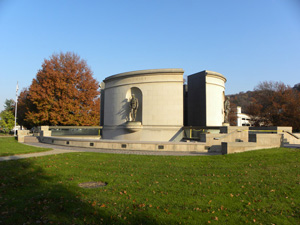

Remember...
Clyde Richard Wilson
1918-1941
"A hero is someone who has given his or her life to something bigger than oneself."
Joseph Campbell
 |
Remember...Clyde Richard Wilson
|
U.S. Navy Seaman First Class Clyde Richard Wilson was a native of Paw Paw, a small community near Fairview, Marion County, West Virginia. He was born on October 31, 1918, to Charles C. Wilson and Dolly Ann Tennant Wilson. According to 1920 and 1930 U.S. Federal Census records, he had many siblings, including Thelma Wilson, Roy Wilson, Alice Lucille Wilson, Ray Wilson, Chester Wilson, and another child who died in infancy.
Clyde grew up in a small town that had been hard hit, like the rest of the state, by the Great Depression. The leading industry in West Virginia, coal mining, suffered a virtual collapse, and unemployed workers had to turn to New Deal agencies like the Works Progress Administration and the Public Works Administration to help their families. While it is unknown whether Clyde participated in any programs like the Civilian Conservation Corps, it can be concluded that he had a responsibility to help his large family make it through these tough times.
Clyde married Edna Marie Wilson on December 27, 1939, in Los Angeles, California, and they had a daughter. They did not, however, stay in California. For some time after their marriage they lived together at 322 South Second Street in Clarksburg, Harrison County, West Virginia. At this time, Clarksburg was a struggling, but not abandoned city. Vintage photos show streetcar tracks providing the main transportation through the downtown area.
S1c Wilson enlisted into the U.S. Navy on July 12, 1938, in Clarksburg. He was assigned to the USS West Virginia, known as the "Wee Vee," from Baltimore, Maryland, and his first day on board was November 10, 1938.
Wilson received many military honors for his contribution to World War II, including the American Campaign Medal, the World War II Victory Medal, and a Purple Heart. To honor and commemorate Clyde's sacrifice to his country and community, bridge number 25-24-4.31 (1818) was dedicated to S1c Clyde Richard Wilson in 2008. The bridge is located in Marion County, West Virginia, and crosses the Big Paw Paw Creek. It is officially known as the "Seaman 1st Class Clyde Richard Wilson Memorial Bridge."
Former West Virginia Secretary of State Natalie Tennant is related to Clyde, as he was her father's first cousin. She paid her respects to his grave in 2008 when her husband was on active duty in Hawaii and said on her social media, "Clyde Wilson never knew the daughter that he had. He wasn't there to be the father every child needs in his or her life. For all the men and women who have served our nation:both in times of peace and war:I want to personally thank you for your service to our nation."
Sources Consulted
"Clyde Richard Wilson." HonorStates.org. Accessed 7 April 2017. http://www.honorstates.org/index.php?id=365664.
"How the Wee Vee Was Born [from the Dictionary of American Naval Fighting Ships]." Battleship USS West Virginia (BB-48). Accessed 7 April 2017. http://www.usswestvirginia.org/uss_west_virginia_history.htm.
Thomas, Jerry Bruce. "The Great Depression." e-WV: The West Virginia Encyclopedia. 9 August 2012. Accessed 7 April 2017. https://www.wvencyclopedia.org/articles/2155.Br>
"United States Pacific Fleet Battleship, Battle Forces, U.S.S. West Virginia." Battleship USS West Virginia (BB-48). Accessed 7 April 2017. http://www.usswestvirginia.org/battle_report.htm.
Article prepared by Olivia Ward , George Washington High School Advanced Placement U.S. History
2017

West Virginia Archives and History welcomes any additional information that can be provided about these veterans, including photographs, family names, letters and other relevant personal history.